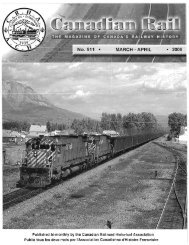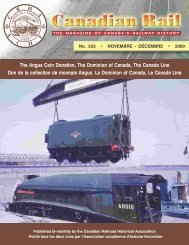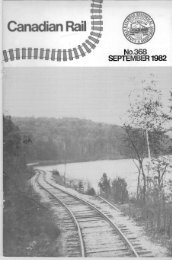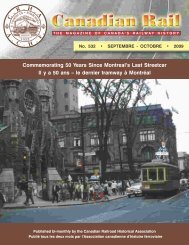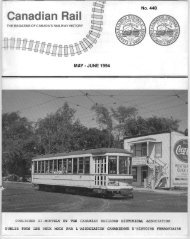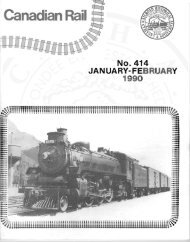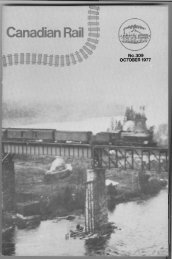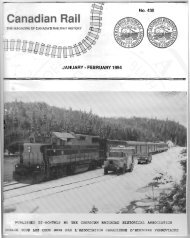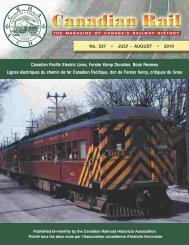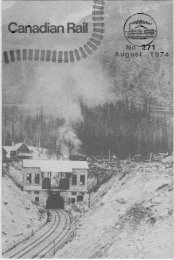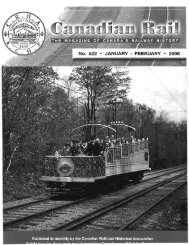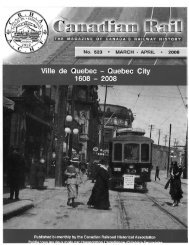Canadian Rail_no539_2010 - Le musée ferroviaire canadien
Canadian Rail_no539_2010 - Le musée ferroviaire canadien
Canadian Rail_no539_2010 - Le musée ferroviaire canadien
You also want an ePaper? Increase the reach of your titles
YUMPU automatically turns print PDFs into web optimized ePapers that Google loves.
NOVEMBER – DECEMBER <strong>2010</strong><br />
263 CANADIAN RAIL • 539<br />
Before long I had the hang of it and was able to<br />
spell the fireman off at regular intervals on that trip to<br />
Steep Rock. It didn’t require too much effort at first, but<br />
as the miles rolled by and the time wore on, I began to get<br />
a much better understanding of just how much effort went<br />
into shovelling many tons of coal into the firebox of an<br />
engine that was lurching down the track.<br />
The art of good combustion<br />
Shovelling the coal into a hand-fired engine,<br />
especially on rough track, as is the case on most branch<br />
lines, is not the easiest thing in the world to do. It’s not<br />
enough to just open the fire doors and throw in the coal in<br />
any old fashion.<br />
To get proper combustion and even burning,<br />
each shovel full had to be spread out uniformly over a<br />
section of the firebox so as to prevent piling all in one spot.<br />
If the coal did pile up in the firebox, only the outer edges<br />
would burn and before long the steam pressure in the<br />
boiler would begin dropping. If you were just a beginner<br />
and were unlucky enough to get coal piled in several<br />
places (as was often the case), then it became necessary to<br />
take the poker and try to spread the piles of coal around to<br />
get them burning. This usually did the trick and kept<br />
steam pressure up until the next stop. It then was often<br />
necessary to shake the grates to get rid of excess coal that<br />
was hindering combustion.<br />
The brakeman’s seat<br />
When not shovelling coal, I was in the<br />
brakeman’s little seat jammed in beside the boiler ahead<br />
of the fireman’s seat. This was a hot place to sit and if you<br />
had a bare arm, it frequently got burned on the side of the<br />
boiler. From it I frequently looked back for hot boxes.<br />
And with the loads of rock, it wasn’t at all uncommon for a<br />
journal to develop a hotbox, particularly in the winter.<br />
After several stops for water, we were finally on the<br />
homeward leg of our journey. Shortly after midnight, we<br />
set our train out on the siding at St. James, and then<br />
proceeded as a caboose-hop over to the Fort Rouge yard.<br />
We shoved the caboose into the caboose track, bid<br />
farewell to the tail-end crew and then hurried to the shop<br />
track with the engine. All in all, it was a very successful trip<br />
but I was glad it was over.<br />
Fireman in action on a ‘hand<br />
bomber’. CPR Archives A 120335.<br />
Un chauffeur “avec sa pelle” en<br />
action. Archives CPR A 120335.<br />
Workers hosing down the grates at<br />
Truro, Nova Scotia on May 3, 1943.<br />
The 3199 was a S-1-j 2-8-2 built in<br />
Pointe Saint Charles Shops in 1926.<br />
Al Paterson.<br />
Des ouvriers nettoient des grilles à<br />
Truro, Nouvelle-Écosse en ce<br />
3 mai 1943. La no 3199 était une<br />
2-8-2 S-1-j construite dans les<br />
ateliers de Pointe-Saint-Charles en<br />
1926. Al Paterson.<br />
continued on page 273



